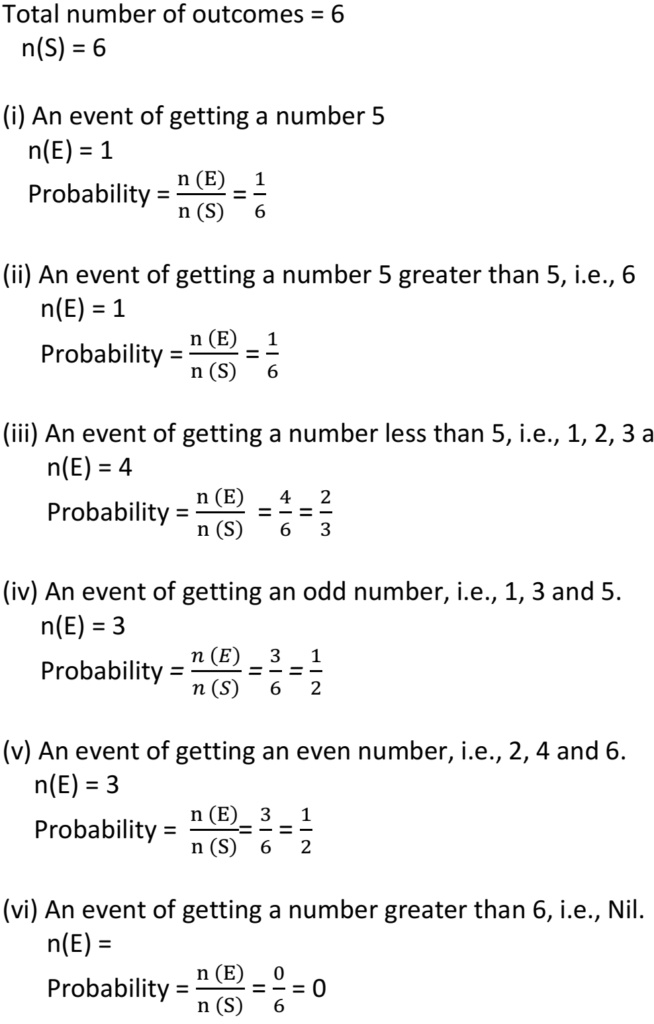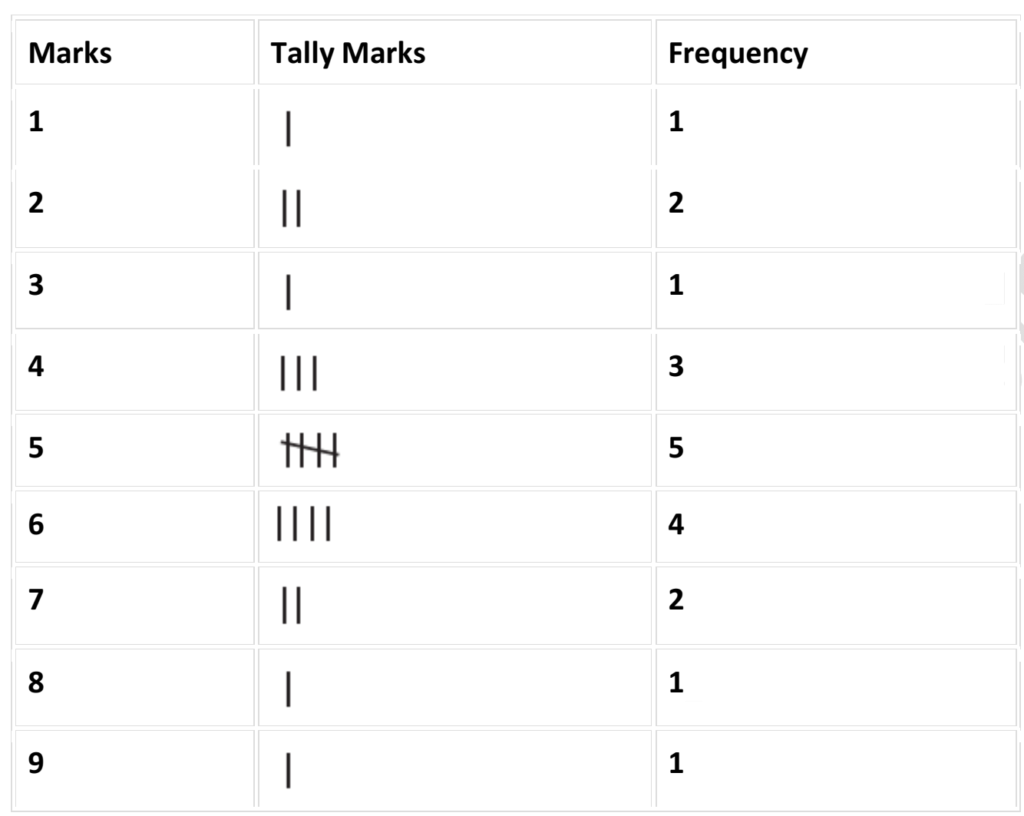Q 1 – A fair die is rolled, find the probability of getting a prime number.
Ans.

Q 2 – A bag contains 5 white and 9 red balls. One ball is drawn at random from the bag. Find the probability of getting
(a) a white ball
(b) a red ball
Ans.

Q 3 – A dice is tossed once. Find the probability of getting
(i) a number 5
(ii) a number greater than 5
(iii) a number less than 5
(iv) an odd number
(v) an even number
(vi) a number greater than 6
Ans.

Q 4 – Organise the following marks in a class assessment, in a tabular form.
4, 6, 7, 5, 3, 5, 4, 5, 2, 6, 2, 5, 1, 9, 6, 5, 8, 4, 6, 7
(i) Which number is the highest? (ii) Which number is the lowest?
(iii) What is the range of the data? (iv) Find the arithmetic mean.
Ans.
First, we have to arrange the given marks in ascending order.
= 1, 2, 2, 3, 4, 4, 4, 5, 5, 5, 5, 5, 6, 6, 6, 6, 7, 7, 8, 9
Now, we will draw the frequency table of the given data.

(i) By observing the table clearly, the highest number among the given data is 9.
(ii) By observing the table clearly, the lowest number among the given data is 1.
(iii) We know that, Range = Highest value – Lowest value
= 9 – 1
= 8
(iv) Now we have to calculate Arithmetic Mean,
Arithmetic mean = (Sum of all observations)/ (Total number of observation)
Then,
Sum of all observation = 1 + 2 + 2 + 3 + 4 + 4 + 4 + 5 + 5 + 5 + 5 + 5 + 6 + 6 + 6 + 6 + 7 + 7
+ 8 + 9
= 100
Total Number of Observation = 20
Arithmetic mean = (100/20)
= 5
Q 5 – Read the bar graph (Fig 3.4) which shows the number of books sold by a bookstore during five consecutive years and answer the following questions:
(i) About how many books were sold in 1989? 1990? 1992?
(ii) In which year were about 475 books sold? About 225 books sold?
(iii) In which years were fewer than 250 books sold?
(iv) Can you explain how you would estimate the number of books sold in 1989?

(i) By observing bar graph,
175 books were sold in the year 1989.
475 books were sold in the year 1990.
225 books were sold in the year 1992.
(ii) By observing bar graph,
475 books were sold in the year 1990.
225 books were sold in the year 1992.
(iii) By observing bar graph,
In the years 1989 and 1992, the number of books sold were less than 250.
(iv) By observing the bar graph, we can conclude that,
The number of books sold in the year 1989 is about 1 and ¾th part of 1 cm.
WKT, Scale is taken as 1 cm = 100 books
= 100 + (¾ × 100)
= 100 + (3 × 25)
= 100 + 75
= 175
Q 6 – Number of children in six different classes are given below. Represent the data on a bar graph.
| Class | Fifth | Sixth | Seventh | Eighth | Ninth | Tenth |
| Number of Children | 135 | 120 | 95 | 100 | 90 | 80 |
(a) How would you choose a scale?
(b) Answer the following questions:
(i) Which class has the maximum number of children? And the minimum?
(ii) Find the ratio of students of class sixth to the students of class eight.
Ans.

(a) We will take the scale as 1 unit = 10 children. Because, we can represent a better and clear difference among the number of students of class 7th and class 9th.
(b) (i) Class 5th has the maximum number of children i.e. 135 and class 7th has the minimum number of children i.e. 95.
(ii) The total number of students in class 6th is 120 and the total number of students in class 8th is 100
Then,
Ratio between the number of students of class 6th and 8th,
= (120/100)
= 6/5
= 6 : 5
Q 7 – The performance of a student in 1st Term and 2nd Term is given. Draw a double bar graph choosing appropriate scale and answer the following:
| Subject | English | Hindi | Maths | Science | S. Science |
| 1st Term (M.M. 100) | 67 | 72 | 88 | 81 | 73 |
| 2nd Term (M.M. 100) | 70 | 65 | 95 | 85 | 75 |
(i) In which subject, has the child improved his performance the most?
(ii) In which subject is the improvement the least?
(iii) Has the performance gone down in any subject?

(i) By observing the double bar graph, there was a maximum marks increase in the Maths subject. So, the child has improved his performance in Maths.
(ii) By observing the double bar graph, the improvement was the least in S. Science.
(iii) By observing the double bar graph, the performance in Hindi has gone down.
Q 8 – Consider this data collected from a survey of a colony.
| Favourite Sport | Cricket | Basket Ball | swimming | Hockey | Athletics |
| Watching | 1240 | 470 | 510 | 430 | 250 |
| Participating | 620 | 320 | 320 | 250 | 105 |
(i) Draw a double bar graph choosing an appropriate scale.
What do you infer from the bar graph?
(ii) Which sport is most popular?
(iii) Which is more preferred, watching or participating in sports?

(i) The fig above is the double bar graph. Which represents the people who prefer either watching or participating in different sports. By observing the double bar graph, we came to conclude that most of the people like watching and participating cricket while least number of people like watching and participating in Athletics.
(ii) By observing the double bar graph, we came to conclude that the people who like watching and participating in cricket is the tallest among all the bars. So, cricket is the most popular sport.
(iii) By observing the double bar graph, we came to conclude that watching sports has more preference, rather than participating in sports.
Q 9 – Take the data giving the minimum and the maximum temperature of various cities given in the beginning of this Chapter (Table 3.1). Plot a double bar graph using the data and answer the following:
(i) Which city has the largest difference in the minimum and maximum temperature on the given date?
(ii) Which is the hottest city and which is the coldest city?
(iii) Name two cities where maximum temperature of one was less than the minimum temperature of the other.
(iv) Name the city which has the least difference between its minimum and the maximum temperature.
Ans.

(i) By observing the double bar graph, we came to conclude that Jammu has the largest difference in the minimum and maximum temperature on 20.6.2006.
(ii) By observing the double bar graph, we came to conclude that Jammu is the hottest city and Bangalore is the coldest city.
(iii) By observing the double bar graph, Bangalore and Jaipur, Bangalore and Ahmedabad. For Bangalore, the maximum temperature was 28oC, while minimum temperature of both Ahmadabad and Jaipur was 29oC.
(iv) By observing the double bar graph, Mumbai has the least difference between its minimum and the maximum temperature.
Q 10 – Assertion: The range of the data: 21, 6, 17, 18, 12, 8, 4, 13 is17
Reason: The difference between the highest and lowest observations in a given data is called its Range.
a) Both assertion and reason are correct and reason is the correct explanation for assertion.
(b) Both assertion and reason are correct and reason is not the correct explanation for assertion.
(c) The Assertion is incorrect but the reason is correct.
(d) Both assertion and reason are incorrect.
Ans. a) Both assertion and reason are correct and reason is the correct explanation for assertion.
Q 11 – Assertion: The median of the data: 3, 4, 5, 6, 7, 3, 4 is 4
Reason: The difference between the highest and lowest observations in a given data is called its Range.
a) Both assertion and reason are correct and reason is the correct explanation for assertion.
(b) Both assertion and reason are correct and reason is not the correct explanation for assertion.
(c) The Assertion is incorrect but the reason is correct.
(d) Both assertion and reason are incorrect
Ans. (b) Both assertion and reason are correct and reason is not the correct explanation for assertion.
Q 12 – Assertion: The probability of an event which is certain to happen is 1.
Reason: The probability of a given data is defined as Sum of all observations by the Number of observations.
a) Both assertion and reason are correct and reason is the correct explanation for assertion.
(b) Both assertion and reason are correct and reason is not the correct explanation for assertion.
(c) The Assertion is correct but the reason is incorrect.
(d) Both assertion and reason are incorrect.
Ans. (c) The Assertion is correct but the reason is incorrect.
Q 13 – The range of the weights (in kg) of a students of a class given below is:
49, 60, 47, 50, 47, 59, 58, 45, 53
(a) 10
(b) 15
(c) 20
(d) 2
Ans. (b) 15
Q 14 – The marks of 11 students of a class are as given below:
78, 11, 99, 63, 94, 6, 78, 36, 30, 55, 22
The range of marks is
(a) 90
(b) 91
(c) 92
(d) 93
Ans. (d) 93
Q 15 – The marks of some students are as given below:
30, 31, 32, 32, 33, 32, 34, 35, 30, 31, 33, 32
Find the mode of their marks.
(a) 30
(b) 31
(c) 32
(d) 33
Ans. (c) 32